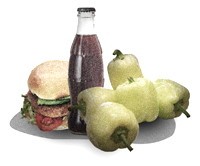Keeping things fresh
One of the most common reasons why people do not buy fresh fruit and vegetables is that they say they cannot eat the fresh produce fast enough before it starts to go bad. If you try out the following tricks, you will never have to use that excuse again:
1. Freeze it: If your bananas are looking more black than yellow, don’t toss them in the garbage. Instead, peel your bananas and break them into four to six pieces. Put them in a sealed ziplock bag in the freezer. Bananas can be difficult to peel when they are frozen, so it makes life easier for yourself if you peel them before you freeze them. Use the frozen bananas in smoothies or baked goods. Mix them in the food processor with cocoa powder and cinnamon for a delicious and healthy faux “chocolate ice cream.”
Chop up any other fruit or vegetable into smaller pieces before you freeze them to make prep work a breeze when you want to use them. Add the frozen produce to soups, yogurts, frittata, lasagna… You name it!
2. Hide it: Fruit and vegetables can be added to just about anything. This works especially well when the produce isn’t looking its best. If you add a wrinkly vegetable to casseroles or spaghetti sauce, you won’t be able to taste the difference.
3. Dehydrate it: Just like freezing produce, drying it is an excellent way to save it before it spoils. Drying times in the dehydrator vary, but typically if you slice up your fruit and vegetables and dehydrate them overnight, they will be ready when you wake up in the morning.
If you cannot eat your fresh produce fast enough, by all means buy the pre-frozen or canned versions. Frozen produce preserves the nutrients exceptionally well in food and can be kept in the freezer for months on end. However, read the ingredients list before you buy: sometimes frozen bags of produce include added salts or sugars. Make sure that the only ingredients in the bag are the fruits and vegetables themselves.
Canned fruit and vegetables are trickier because they almost always include added preservatives. Choose the kind with as few extra ingredients as possible. For canned vegetables that already have salt added, rinse them in a strainer when you open the can. Running water over them for a minute or two should remove most of the sodium content.
You can apply the above ideas to fruit and vegetables that you do not like the taste of, as well. The flavours can change drastically when the chemical composition of the food is altered, such as when it is dehydrated. Hiding the fruit or vegetable in another dish prevents you from being confronted with the full potency of that particular fruit or vegetable. This will give you the nutritional benefits of the food, pain free.
Published in Volume 64, Number 17 of The Uniter (January 28, 2010)







